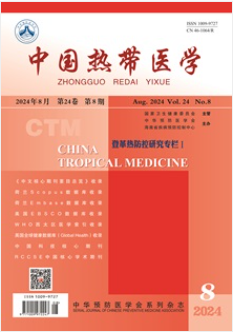Results comparing on the internal control of RT-PCR on SARS-CoV-2 by two different nucleic acid extraction methods of releasant
引用次数: 0
Abstract
Objective Extraction of nucleic acid of SARS-CoV-2 with releasing agent by one-step method was optimized to improve the detection rate of the internal control (IC) in RT-PCR, reduce the re-examination rate caused by the non-detection of IC, and improve the time efficiency of report. Methods The nucleic acid test samples of severe acute respiratory syndrome coronavirus 2 (SARS-CoV-2) from the PCR laboratory of Bao ' an Hospital of Traditional Chinese Medicine, were applied to extract nucleic acid with releasing agent one-step method that optimized by the laboratory, and compared with the original method in the kit specification: To observe the changes of IC amplification curve and cycle threshold ( Ct ); to compare the change of the review rate before and after. Results The amplification curves of IC were scattered between Ct24-44 before the optimization, and there were no amplification curves in several samples when unoptimized. After the optimization, the amplification curves were concentrated in the range of Ct 22-34, and all showed typical “S” shape; the Ct of samples were significantly lower than that before the optimized ( t =5.937 0, P 0.05); the Ct of N ( F =1.032, P = 0.970 1) and ORF1a/b ( F =1.262, P =0.784 8) gene in the positive quality evaluation samples were in the same case ( P >0.05). The overall sample review rate was also significantly reduced ( F =3.899 0, P =0.025 8). Conclusion The optimized one-step method for nucleic acid extraction is simple, convenience, and short test time. Without affecting the Ct of N and ORF1a/b gene in the SARS-CoV-2 positive samples, the results after amplification are obviously better than before, and reduced the rate of review, shorted the reporting time, which ease the burden of the huge detection pressure. 摘要:目的 对新型冠状病毒核酸释放剂一步提取法进行优化, 提高内标在荧光定量逆转录PCR中的检出效率, 降低因内标未检出带来的复査率, 提高核酸检测报告时效性。 方法 对深圳市宝安中医院PCR实验室的新型冠状病 毒核酸检测标本, 采用本实验室优化方法用释放剂一步法提取核酸, 与试剂盒说明书原方法进行比较, 观察两种方法提取核酸后内标扩增曲线及 Ct 值的不同;比较前后复査率改变。 结果 优化前, 各样本内标扩增曲线在 Ct 24〜44之间 散在分布, 部分样本内标未出现扩增曲线。经优化后, 各样本内标的扩增曲线集中在 Ct 22〜34之间, 且全部呈现典型 “S”型曲线;各样本内标的扩增起始循环 Ct 值明显小于优化前( t =5.937 0, P 0.05);优化前后, 阳性质评标本 N 基因 ( F =1.032, P =0.970 1)与 ORF1a/b 基 因 ( F =1.262, P =0.784 8), Ct 值差异均无统计学意义( P >0.05)。优化后样本总体复査率较优化前显著降低( F =3.899 0, P =0.025 8)。 结论 优化后的一步法提取核酸方法简单、便捷、用时短, 在不影响新型冠状病毒阳性标本 N 基因及 ORF1a/b 基因 Ct 值的同时, 内标检出结果明显优化, 降低了复査率, 缩短了报告发放时限, 提高检测效率。结果比较两种不同核酸提取方法对SARS-CoV-2的RT-PCR内控效果
目的优化利用释放剂一步法提取SARS-CoV-2核酸,提高RT-PCR中内控(IC)的检出率,减少因内控未检出而导致的复检率,提高报告的时间效率。方法采用宝安中医医院PCR实验室采集的SARS-CoV-2核酸检测标本,采用本实验室优化的释放剂一步法提取核酸,并与试剂盒说明书中原方法进行比较:观察IC扩增曲线和周期阈值(Ct)的变化;比较前后复核率的变化。结果优化前,IC的扩增曲线在Ct24-44之间较为分散,未优化时,部分样品无扩增曲线。优化后扩增曲线集中在Ct 22 ~ 34范围内,均呈典型的“S”型;样品的Ct值显著低于优化前(t =5.937 0, P 0.05);阳性质量评价样品中N基因(F =1.032, P = 0.970 1)和ORF1a/b基因(F =1.262, P =0.784 8)的Ct值相同(P >0.05)。总检检率显著降低(F =3.899 0, P =0.025 8)。结论优化后的一步法提取核酸简单、方便、检测时间短。在不影响SARS-CoV-2阳性样本中N和ORF1a/b基因Ct的情况下,扩增后的结果明显优于之前,并且降低了审稿率,缩短了报告时间,减轻了巨大的检测压力。摘要:目的对新型冠状病毒核酸释放剂一步提取法进行优化,提高内标在荧光定量逆转录PCR中的检出效率,降低因内标未检出带来的复査率,提高核酸检测报告时效性。方法对深圳市宝安中医院PCR实验室的新型冠状病毒核酸检测标本,采用本实验室优化方法用释放剂一步法提取核酸,与试剂盒说明书原方法进行比较,观察两种方法提取核酸后内标扩增曲线及Ct值的不同,比较前后复査率改变。结果优化前,各样本内标扩增曲线在Ct 24 ~ 44之间散在分布,部分样本内标未出现扩增曲线。经优化后,各样本内标的扩增曲线集中在Ct 22 ~ 34岁之间,且全部呈现典型“S”型曲线;各样本内标的扩增起始循环Ct值明显小于优化前(t = 5.937 0, P 0.05);优化前后,阳性质评标本N基因(F = 1.032, P = 0.970 1)与ORF1a / b基因(F = 1.262, P = 0.784 8), Ct值差异均无统计学意义(P > 0.05)。(f =3.899 0, p =0.025 8)。结论优化后的一步法提取核酸方法简单,便捷,用时短,在不影响新型冠状病毒阳性标本N基因及ORF1a / b基因Ct值的同时,内标检出结果明显优化,降低了复査率,缩短了报告发放时限,提高检测效率。
本文章由计算机程序翻译,如有差异,请以英文原文为准。
求助全文
约1分钟内获得全文
求助全文
来源期刊
CiteScore
0.60
自引率
0.00%
发文量
13927
期刊介绍:
China Tropical Medicine, was approved by the Ministry of Science and Technology in 2001, is the only tropical medicine periodical under the charge of the National Health Commission of China. It’s organized by Hainan Provincial Center for Disease Prevention and Control, and Chinese Preventive Medicine Association.
The journal is indexed by the following database: Scopus database, Embase database, EBSCO Database, The Western Pacific Region index medicus (WPRIM), American Chemical Abstracts (CA), International Centre for Agricultural and Biological Sciences Research Database (CABI), Global Health Database, Database of the Ulrich's Periodicals Directory, China Science and Technology Core Journals, China Core Journals (Selection) Database, Database of Chinese Biomedical Literature, Comprehensive Evaluation Database of Chinese Academic Journals, CAJCD Code of Conduct Excellent Journal, Database of Chinese SCI-Tech Periodicals, China Journal Full Text Database.

 求助内容:
求助内容: 应助结果提醒方式:
应助结果提醒方式:


